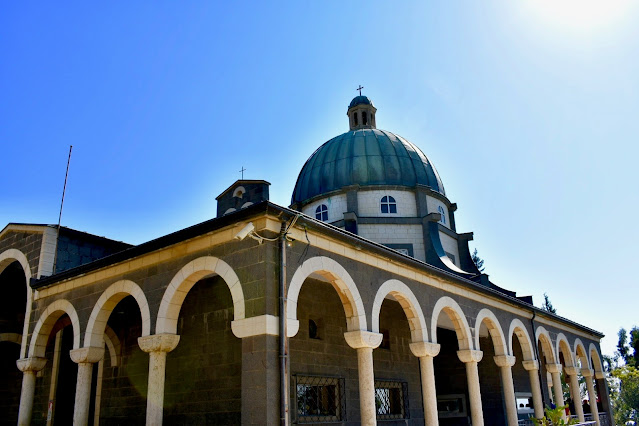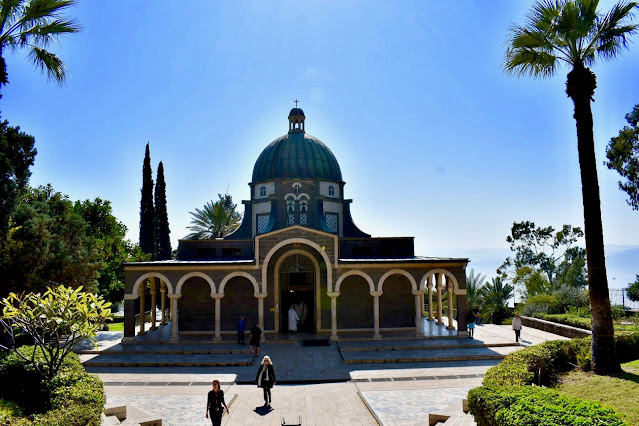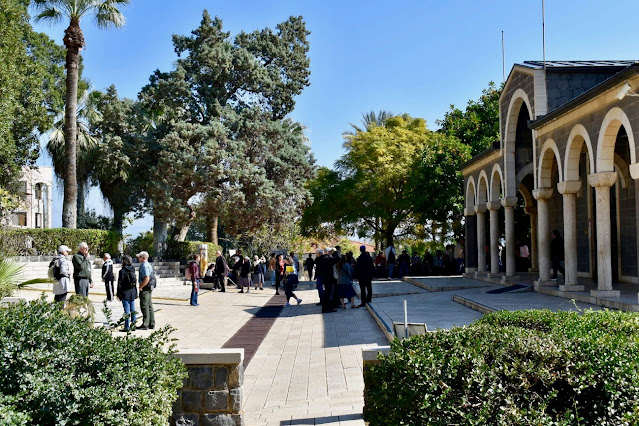The day of Thursday, February 6th was a very busy day. This day will get split into many separate posts. This one jumps into the middle of the day or at least late in the morning. I would consider this Day 4, part 4, since I suspect I will have 3 other posts to cover the events of the day prior to this stop.
We visited the Church of the Beatitudes on the Mount of Beatitudes. Although Galilee is a region of Israel with more fertile conditions and some lush green vegetation, the Mount of Beatitudes stands out as being one of the most lush. It's on the side of a hill and has more diversity in plant life than anywhere else I saw in Israel. Capernaum was perhaps second to this mount in terms of plant life, which makes sense since it's about a mile away on foot. The Mount of Beatitudes thus brings about some abundance, which seems fitting for this location. It's at the base of this mount, no more than a mile walk downhill that one finds Tabgha, the site of the multiplication of the loaves and fish. The roadways are not direct, so if one drove the distance, it's more than one mile. The Church of the Beatitudes is also a similar distance (on foot) from Capernaum, where Jesus based his ministry.
People tend to know that the Dead Sea is the lowest point on earth. But the Jordan River that feeds into it flows out of the Sea of Galilee, which is also below sea level. So the peak of the Mount of Beatitudes is BELOW sea level, making it one of the world's lowest peaks.
The Church of the Beatitudes is a rather modern church, having been built in the 1930s. Older structures existed on the mount, but there didn't seem to be much, if any attention given to any of that. This site is just plain beautiful. BEATITUDE and BEAUTIFUL start with similar spellings, and I now associate the two quite closely. Clicking on photos allows you to see them in much better detail, and you can more quickly cycle through them.
The next few photos focus on the building from the outside. Toward the end of this line of photos, one starts to see the garden-like grounds around the church.
The plant life stood out at this location.
A photo taken from a distance shows the church amidst the vegetation. The sheets that seem to cover the land hold moisture in for the banana crops. It reduces the moisture loss by roughly 30%, which is a big deal in a country that had been so arid and took efforts like this to make it so green in so much of the country.
But this is a church, not just some pretty place. So let's head inside. This is the setting for the Sermon on the Mount. A famous work of art depicting this appears over the entryway to the church building. It shows Jesus up high and others lower down. I've heard the disciple has a meaning that one is at one's feet, learning, etc. Of course natural amphitheaters like this hillside usually work best if the speaker is lower than the audience. That way, their voice is projecting straight toward them, and the reflected voice bounces along the tops of the people and amplifies the sound where it would otherwise be at its weakest.
Like many of the holy sites, there is a sign reminding us that this is a house of prayer. Guides usually have to explain the particulars of a site outside or they use a whisper box. A whisper box is a small transmitter with a microphone. The box is usually blue for the transmitter, and gray for the receivers that the rest of us have. They have a few basic controls like volume, channel number, and power control.
A song/chant book was open that appeared to have great attention to detail in its composition. Members of our group are in the background praying. I focused on the book. Looking up from there, one sees the golden dome. And below the dome, of course is the altar in the center of the space.
There was a plaque that I believe was trying to list out the Beatitudes, but it was Greek to me.
I took note of the quote of the persecuted, and only later noticed that "heaven" was missing an "a".
Sometime after we had left the area, someone asked me if I had a photo of something that they took a short video of, which involved the tablets about those who thirst coming and drinking. They thought they had a funny shot, and it was funny. When I quickly looked through my photos, I only saw the tablet and not the sign next to it. I was surprised that I would miss something so funny. Only after the trip did I see that I in fact had the photo I hoped I had. "Let anyone who thirst[s] come to me and drink..." is on a tablet in an area with water flowing near the tablet. So it was probably necessary for people who used a bad interpretation of it or were just thirsty for water that there is also a sign saying "Water not for drink".
There were plenty of other beautiful things to see there. It seems like a place where I would gladly spend a morning or afternoon, and gladly walk to some of the places Jesus spent much more time in the communities at the base of the hill on the shore of the Sea of Galilee.
Again, this is a site of great beauty. I spent some time walking around the pathways around the church. I doubled back when I realized I was on a path that had no other ways off the path before running into a gathering of people who had a prayer service going on. I had quickly stepped or jogged a bit ahead of the group that chose to do the same as I was doing, so I was able to get back to them very close to the last spot where one could choose to bypass the prayer group and give them a respectable space for their group.
There was much to take in, so it was harder for me to take the time to pray. I was also noting the vegetation. We were finally somewhere with a certain combination I was looking for, but it had much more variety than I was looking for, and that variety was wonderful. I felt like it was a little more in tourist mode than pilgrim mode, but I did try to have a little of both at each site.
A tourist takes in the sites, they are looking for photos, souvenirs, etc. These are taking actions while onsite, although one might be bringing photos to share with people one knows will never get a chance to go themselves, or to bring to people who might be more likely to go if they see what they are missing. A pilgrim worships, transforms internally, etc. These are more giving or changing actions. In such a place as Israel, one should be a pilgrim first, and yet one can also be a tourist. But I don't recommend prioritizing the tourist aspects.
Although there is a church on this site, the number of people going in and out of it make me think I wouldn't pray very long inside, as I prayed a very short time inside. I think I'm more likely to take in the nature outside and pray there. If I had a few days in that region to do what I wanted, I would spend the day on the hillside and wandering to the nearest two towns. One can see the Sea of Galilee from the hillside, but I didn't include photos I took specifically of that view.
This was a peaceful place on a day that began long before the normal time to wake up with the sounds in the sky of something not at all peaceful. But that's for a separate post. (We were very safe, but Iranians near Damascus were not as safe.)
We visited the Church of the Beatitudes on the Mount of Beatitudes. Although Galilee is a region of Israel with more fertile conditions and some lush green vegetation, the Mount of Beatitudes stands out as being one of the most lush. It's on the side of a hill and has more diversity in plant life than anywhere else I saw in Israel. Capernaum was perhaps second to this mount in terms of plant life, which makes sense since it's about a mile away on foot. The Mount of Beatitudes thus brings about some abundance, which seems fitting for this location. It's at the base of this mount, no more than a mile walk downhill that one finds Tabgha, the site of the multiplication of the loaves and fish. The roadways are not direct, so if one drove the distance, it's more than one mile. The Church of the Beatitudes is also a similar distance (on foot) from Capernaum, where Jesus based his ministry.
People tend to know that the Dead Sea is the lowest point on earth. But the Jordan River that feeds into it flows out of the Sea of Galilee, which is also below sea level. So the peak of the Mount of Beatitudes is BELOW sea level, making it one of the world's lowest peaks.
The Church of the Beatitudes is a rather modern church, having been built in the 1930s. Older structures existed on the mount, but there didn't seem to be much, if any attention given to any of that. This site is just plain beautiful. BEATITUDE and BEAUTIFUL start with similar spellings, and I now associate the two quite closely. Clicking on photos allows you to see them in much better detail, and you can more quickly cycle through them.
 |
| Church of the Beatitudes |
The next few photos focus on the building from the outside. Toward the end of this line of photos, one starts to see the garden-like grounds around the church.
The plant life stood out at this location.
A photo taken from a distance shows the church amidst the vegetation. The sheets that seem to cover the land hold moisture in for the banana crops. It reduces the moisture loss by roughly 30%, which is a big deal in a country that had been so arid and took efforts like this to make it so green in so much of the country.
But this is a church, not just some pretty place. So let's head inside. This is the setting for the Sermon on the Mount. A famous work of art depicting this appears over the entryway to the church building. It shows Jesus up high and others lower down. I've heard the disciple has a meaning that one is at one's feet, learning, etc. Of course natural amphitheaters like this hillside usually work best if the speaker is lower than the audience. That way, their voice is projecting straight toward them, and the reflected voice bounces along the tops of the people and amplifies the sound where it would otherwise be at its weakest.
Like many of the holy sites, there is a sign reminding us that this is a house of prayer. Guides usually have to explain the particulars of a site outside or they use a whisper box. A whisper box is a small transmitter with a microphone. The box is usually blue for the transmitter, and gray for the receivers that the rest of us have. They have a few basic controls like volume, channel number, and power control.
A song/chant book was open that appeared to have great attention to detail in its composition. Members of our group are in the background praying. I focused on the book. Looking up from there, one sees the golden dome. And below the dome, of course is the altar in the center of the space.
There was a plaque that I believe was trying to list out the Beatitudes, but it was Greek to me.
I took note of the quote of the persecuted, and only later noticed that "heaven" was missing an "a".
Sometime after we had left the area, someone asked me if I had a photo of something that they took a short video of, which involved the tablets about those who thirst coming and drinking. They thought they had a funny shot, and it was funny. When I quickly looked through my photos, I only saw the tablet and not the sign next to it. I was surprised that I would miss something so funny. Only after the trip did I see that I in fact had the photo I hoped I had. "Let anyone who thirst[s] come to me and drink..." is on a tablet in an area with water flowing near the tablet. So it was probably necessary for people who used a bad interpretation of it or were just thirsty for water that there is also a sign saying "Water not for drink".
There were plenty of other beautiful things to see there. It seems like a place where I would gladly spend a morning or afternoon, and gladly walk to some of the places Jesus spent much more time in the communities at the base of the hill on the shore of the Sea of Galilee.
Again, this is a site of great beauty. I spent some time walking around the pathways around the church. I doubled back when I realized I was on a path that had no other ways off the path before running into a gathering of people who had a prayer service going on. I had quickly stepped or jogged a bit ahead of the group that chose to do the same as I was doing, so I was able to get back to them very close to the last spot where one could choose to bypass the prayer group and give them a respectable space for their group.
There was much to take in, so it was harder for me to take the time to pray. I was also noting the vegetation. We were finally somewhere with a certain combination I was looking for, but it had much more variety than I was looking for, and that variety was wonderful. I felt like it was a little more in tourist mode than pilgrim mode, but I did try to have a little of both at each site.
A tourist takes in the sites, they are looking for photos, souvenirs, etc. These are taking actions while onsite, although one might be bringing photos to share with people one knows will never get a chance to go themselves, or to bring to people who might be more likely to go if they see what they are missing. A pilgrim worships, transforms internally, etc. These are more giving or changing actions. In such a place as Israel, one should be a pilgrim first, and yet one can also be a tourist. But I don't recommend prioritizing the tourist aspects.
Although there is a church on this site, the number of people going in and out of it make me think I wouldn't pray very long inside, as I prayed a very short time inside. I think I'm more likely to take in the nature outside and pray there. If I had a few days in that region to do what I wanted, I would spend the day on the hillside and wandering to the nearest two towns. One can see the Sea of Galilee from the hillside, but I didn't include photos I took specifically of that view.
This was a peaceful place on a day that began long before the normal time to wake up with the sounds in the sky of something not at all peaceful. But that's for a separate post. (We were very safe, but Iranians near Damascus were not as safe.)




















Comments
Post a Comment